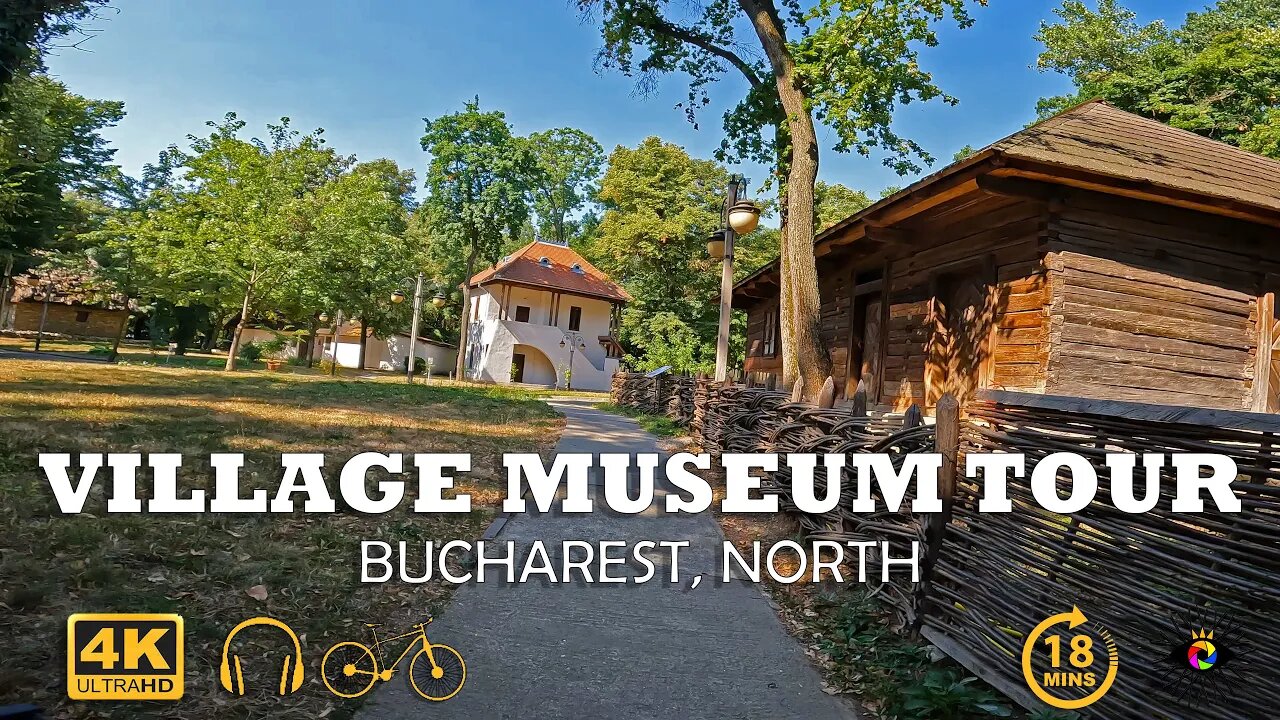Premium Only Content

NATIONAL Village MUSEUM, BUCHAREST | 4k Virtual Tour | 🇷🇴
#virtualtour #indoorcycling #bucharest #bucuresti #bucarest #romania #citytour #cityscape #cyclingvlog #touristplace #discoverromania #cyclingworkout #cyclingaddict #urbancycling #museumtour
This video features a 4k virtual tour of the National Village Museum, in Bucharest. Closed Captions [CC] which include historical facts and descriptions are available in all languages.
CHAPTERS :
00:00 - Main exhibition
04:25 - New exhibition
08:37 - Main exhibition
13:20 - By the lake trail
14:39 - Lake view
15:10 - By the lake trail
16:53 - Back on the main road
===============================================================================
🌎Complete Playlist of Virtual Tours: https://www.youtube.com/playlist?list=PLdyvAxFyPXo89pj1Q1oPwDmmVURBP1l8h 🌎
🏔️ Mountain road descents : https://www.youtube.com/playlist?list=PLdyvAxFyPXo8XTKj8xega-31flwsiEaV_ 🏔️
🏞️ Park rides : https://www.youtube.com/playlist?list=PLdyvAxFyPXo-aF6HRtKwq17l1m1LKvf5b 🏞️
🏨 Urban rides : https://www.youtube.com/playlist?list=PLdyvAxFyPXo8uQ-gTaZ3b38SmrEC13pwq 🏨
🌳 Forest rides : https://www.youtube.com/playlist?list=PLdyvAxFyPXo8-7xZMAHzDJmQRP4Dx7ffy 🌳
📢 𝗣𝗹𝗲𝗮𝘀𝗲 𝗦𝘂𝗯𝘀𝗰𝗿𝗶𝗯𝗲! 📢 - youtube.com/channel/UCib-JDIHF_Btivu010jNd5g?sub_confirmation=1
===============================================================================
✔️JOIN US:✔️
➤TikTok: https://www.tiktok.com/@snailsonwheelz?lang=en
➤Instagram: https://www.instagram.com/snails_on_wh33ls/?hl=ro
➤Facebook: https://www.facebook.com/snailsonwheels
===============================================================================
INFO :
On the shores of Lake Herastrau, right in the middle of Romania's capital, visitors from all over the world have the joy of encountering a real "village", with monuments and artifacts from the 17th century to the early 20th century. Representative buildings from important ethnographic areas have been given a second life at the National Village Museum "Dimitrie Gusti".
The idea of an open-air museum in Romania has been around since the second half of the 19th century. In 1867 Alexandru Odobescu, an eminent man of culture, proposed the presentation of monuments of popular architecture in a specially designed pavilion at the Universal Exhibition in Paris. Sometime later, the scholar Alexandru Țzigara Samurcaș was to envisage bringing to the Ethnographic Museum of National Art, Decorative Art and Industrial Art in Bucharest, founded by him in 1906, some "authentic and complete households from all the most significant regions inhabited by Romanians", a project that materialized in 1909, with the exhibition in this museum of a peasant house from Gorj county.
In the 1930s, there were only two open-air museums in Europe: Skansen Museum in Stockholm (Sweden, 1891) and the Bygdoy Museum in Lillehamer (Norway). In our country, at that time, the Ethnographic Museum of Transylvania in "Hoia" Park of Cluj, founded in 1929 by Professor Romulus Vuia, with regional specificity, and the Romanian Village Museum (today the National Village Museum "Dimitrie Guști") in Bucharest, since 1936, with a national character.
The creation of the Village Museum is the result of intense and sustained theoretical and field research, of museographic experiments, for over a decade, coordinated by Professor Dimitrie Gusti, founder of the Sociological School in Bucharest. As head of the Department of Sociology at the University of Bucharest, Gusti organized between 1925-1935, with specialists from various fields (sociologists, ethnographers, folklorists, geographers, statisticians, physicians) and his students, monographic research campaigns of an interdisciplinary nature in a relatively large number of villages (Fundu Moldovei - Suceava county, Nereju - Vrancea county Dragus - Brasov county, Dragomiresti - Maramures county, Clopotiva - Hunedoara county, Runcu - Gorj county, Rusetu - Buzau county etc.).
In accordance with the criteria of authenticity and respect for local building traditions, which are still in force today, the construction of the museum was reassembled under the careful supervision of specialists, primarily Henry H. Stahl and Victor Ion Popa, craftsmen brought from the villages where the monuments originated.
The official opening of the Village Museum took place on 10 May 1936, in the presence of King Charles II, and a week later, on 17 May 1936.
Source : https://muzeul-satului.ro/en/despre-noi/istoric-muzeul-satului/
-
 1:18:24
1:18:24
Glenn Greenwald
14 hours agoLiberals Encourage Family & Friends To Separate Over Political Disputes; Segment Debut Of System Pupdate: Profiles Of Rescued Dogs | SYSTEM UPDATE #373
127K292 -
 1:24:53
1:24:53
Flyover Conservatives
1 day agoMarketing Madness or Manipulation? The War on Western Identity - Alex Newman; Economic Update - Dr. Kirk Elliott | FOC Show
56.2K5 -
 1:15:05
1:15:05
PMG
1 day ago $9.75 earned"Big Pharma EXPOSED: The HIDDEN Cures They Tried to Bury"
47.1K8 -
 3:26:12
3:26:12
Tundra Gaming Live
11 hours ago $2.85 earnedThe Worlds Okayest War Thunder Stream
39.2K1 -
 1:49:52
1:49:52
VOPUSARADIO
18 hours agoPOLITI-SHOCK! Back To Back Guests: Rebekah Koffler & Dr. Michael Schwartz
27.9K -
 59:44
59:44
The StoneZONE with Roger Stone
10 hours agoWill the Perps of the Russian Collusion Hoax Face Justice? | The StoneZONE w/ Roger Stone
40.4K14 -
 2:25:06
2:25:06
WeAreChange
13 hours agoCOMPLETE COLLAPSE: Media Spiraling Into OBLIVION As It Tries To Take Out Elon and Trump
83.2K15 -
 1:56:08
1:56:08
Darkhorse Podcast
17 hours agoTaste the Science: The 253rd Evolutionary Lens with Bret Weinstein and Heather Heying
86.6K85 -
 1:38:09
1:38:09
Barry Cunningham
14 hours agoTRUMP DAILY BRIEFING: Dems Threatening Trump Cabinet And Freaking Out Over Tariffs (and more!)
61.3K88 -
 4:31:46
4:31:46
Viss
15 hours ago🔴LIVE - Viss Arena Breakout Dominance!
113K54